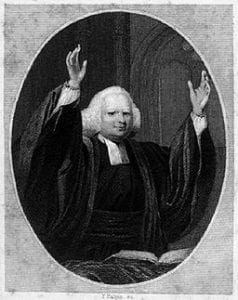Where and When was the Great Awakening?
What was the Great Awakening and when did it happen? These were the questions that our class explored in the fall of 2017.  Many histories of the United States talk about the Great Awakening, the effort by some religious leaders and communities to revive and personalize piety in the eighteenth-century Protestant world, as one of the key events before the American Revolution. It was a time when prominent evangelists, like George Whitefield, and theologians, like Jonathan Edwards, brought the idea of the a spiritual rebirth to a new generation of believers.
Many histories of the United States talk about the Great Awakening, the effort by some religious leaders and communities to revive and personalize piety in the eighteenth-century Protestant world, as one of the key events before the American Revolution. It was a time when prominent evangelists, like George Whitefield, and theologians, like Jonathan Edwards, brought the idea of the a spiritual rebirth to a new generation of believers.

But it was also an era when religious leaders, like Charles Chauncy, objected to the disorder and chaos caused by revivals. Not least, they objected to the many sermons that took place before large gatherings, sometimes outdoors.
Scholars have spend a lot of time discussing, and disagreeing, about the Great Awakening. Some historians have focused on the way these events brought Americans together in new ways, hearing new kinds of religious messages that were often emotional and personal. These gatherings, they argue, helped create the community that fought the American Revolution in the 1770s and 1780s. In still further strands of argument, historians have stressed how these events led to stronger religious institutions, the importance of the Scottish and Continental European origins of the revivals, and the importance of the revivals among Native American and African-American communities. Our class read many of these arguments, then looked in the primary sources ourselves. For those interested in more information, we’ve put a bibliography on this site, and we’ve listed “sources for further reading” on our pages.
Students in our class have investigated many aspects of the Great Awakening, identifying “data points,” our term for events that could be given a specific geographic location during the Great Awakening, and placing them on maps, using ArcGIS Online. (For a student’s eye view of this course, see Faith Perry’s blog.) We have produced a collective portrait of the Great Awakening, as well as group and individual interpretations of our study, At the largest level, our shared map of over eight-hundred events highlights the fact that what historians have called the “Great Awakening” unfolded over decades, and in every region of the Atlantic world. While a few outlier points, like Ethiopia and Bengal, highlight the geographic reach of the movement, the central foci remained in Britain and on the eastern seaboard of North America, centers of Protestant population. We’ve also looked at our main players from the perspective of national/racial origin, and of sex.
Please explore the pages that follow, and see the many aspects of the Great Awakening No single version encompasses the whole. There is no single answer to what the Great Awakening “was.” But taken together, it was an important moment in the history of religion and the history of the United States.
